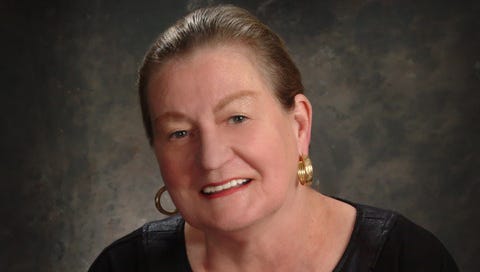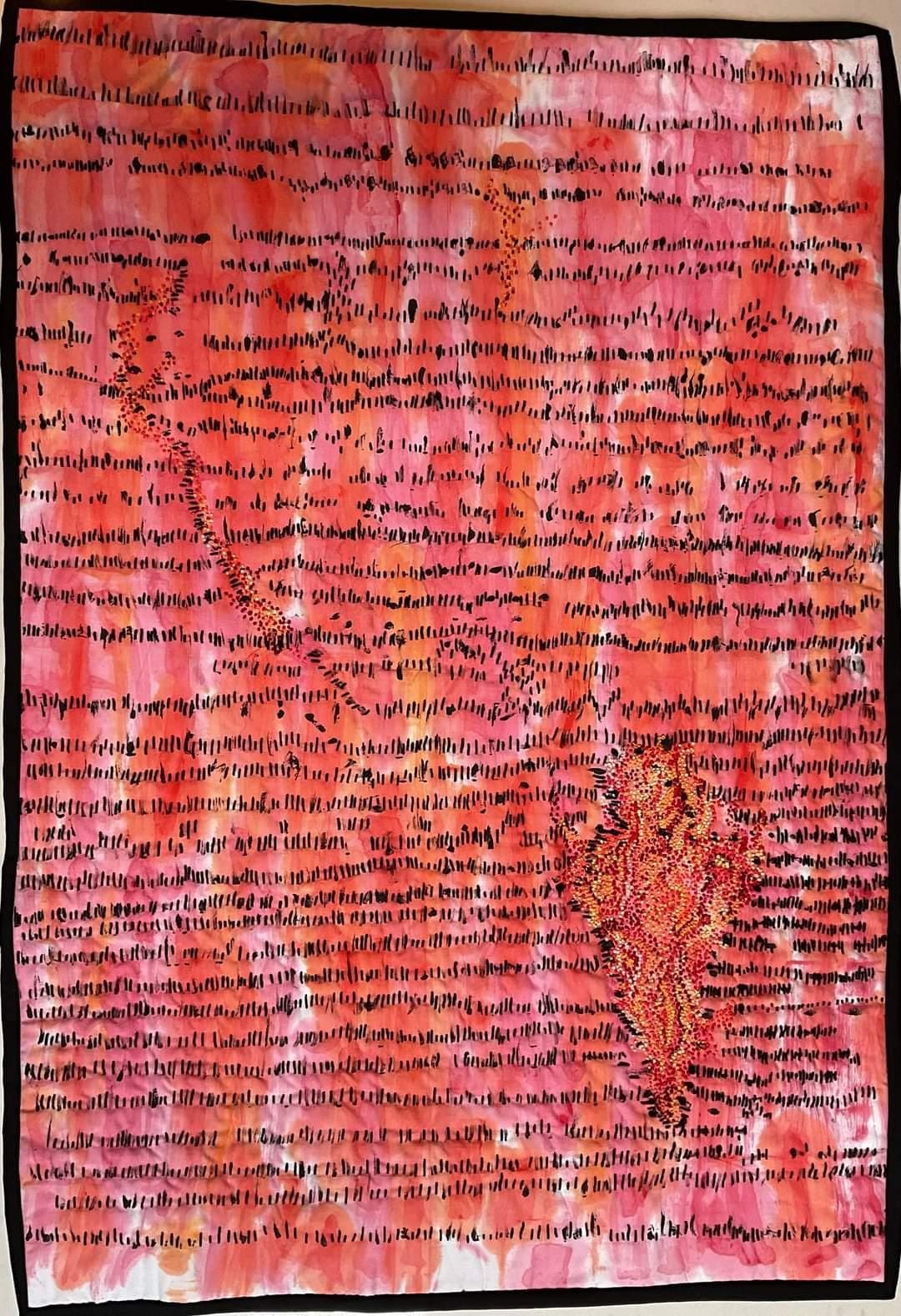Gloria S. Daly is a contemporary textile artist and designer living on Vancouver Island, BC. Even though she is over 80, she works at her craft fulltime. I had the opportunity to interview her recently at a gallery where her work was being displayed.
Three years ago she suffered a stroke but that didn’t stop her doing what she loves, and her latest works were part of her healing therapy. The picture shown here, ‘Fire’ is approximately 24” by 36,” and is one of a collection of five pieces called ‘Elemental Change.’
Susan - Gloria, I know nothing about textile or fibre art. Would you please explain it?
Gloria - Textile, or fibre art as I like to call it, is a language to me that holds the universe together. We are wrapped in cloth the moment we are born and wrapped again as we pass away from this life. Taking slow mindful hand stitches allows me to tell stories, with passion and dedication. I use a needle and thread in the same way a painter would a paint brush.
Susan - Can you tell me about how you first became interested in this medium?
Gloria - I first became interested in fibre art through my early childhood introduction to embroidery. I learned to do basic stitches on bleached flour sacks that we used as tea towels to dry the dishes. As far back as I can remember I loved to stitch but soon tired following patterns. In my twenties, I began to stitch from my own ideas, using designs and colours.
Susan - Were there any particular artists that inspired your early work?
Gloria - Canadian textile artists Dorothy Caldwell, Judy Martin and Marth Cole influenced my work and encouraged me to believe in myself.
Susan - It was later in life before you actually became known as a fibre artist. Can you tell us a little more about your artistic journey?
Gloria - It was many years before my fibre art was taken seriously. Hand stitching has always been considered “woman’s work” and not serious art. I joined local embroidery guilds and over time became a member of the Canadian Embroiderers Board of Directors. It was during this time that I became aware of the UK City & Guilds Program. Finally, at the age of 60, I enrolled and studied Design & Embroidery. I learned to trust my instincts and stitch from the heart for my own pleasure and to not be influenced by what others thought.
Susan - What did you have to do to become recognized as a visual artist in BC?
Gloria - To become a professional visual artist in BC was a goal that took several years to reach. First I received my accreditation through my study in Design & Embroidery with the UK City & Guilds. Then I took several art courses at the University of Vancouver Island, achieving a Master Craftsman designation in Design from The Embroiderers Guild of America. Inc. It was a minimum of two years of artistic practice after my basic training and then producing work at a level finally recognized as professional by other practitioners in my discipline.
Susan - What is one of the things you have enjoyed doing the most?
Gloria - Exhibiting across Canada is always exciting, and I have thoroughly enjoyed group shows at several galleries, as well as my solo shows. Three of my favorites were the Mississippi Valley Textile Museum in Ontario, The Saint John Arts Centre, New Brunswick, and The Cowichan Public Art Gallery, BC.
Susan - What were some of the significant milestones in your artistic career?
Gloria - During a residency in Tokyo, Japan, I had the opportunity to exhibit in the Palos Gallery, and to teach a workshop in an ancient and beautiful tea house. I have found attending both sponsored and self-directed residencies gives me a concentrated period to focus on my art’s creative development.
Susan - Can you share other memorable experiences or projects that had a profound impact on you and your career?
Gloria - When my work was juried into Stories of Migration Contemporary Artists Interpret Diaspora it was a very significant milestone in my career. The show was in collaboration with the George Washington University Museum and the Textile Museum at the university in Washington, DC. The exhibition lasted five months and was a wide range of works juried from hundreds of entries. My piece focused on the Japanese Canadians interned during WWII in British Columbia. I like to work on a big surface. The Diaspora entry was six feet square and only one stitch was repeatedly used, mark making can be very effective when portraying a message.
“The resulting exhibition is filled with art that is not only exciting but also emotionally powerful” - Martha Sielman, Executive Director, Studio Art Quilt Associates, Inc. said. I traveled to Washington, DC to attend the opening reception.
Susan - What would you describe as your creative process?
Gloria - For me the creative process starts with inspiration and can be triggered from something as simple as a source calling for works of art. Inspiration can come at any time or anywhere. Sometimes an idea will come into my subconscious and will grow as I think, sketch, doodle and research the subject. This process may take days, weeks or even months. I can’t be rushed. Insight usually happens when I’m not concentrating on the project, that ‘AHA’ moment!
I will begin with sorting out ideas, self-critiquing, reflecting, and finally the artwork starts to take shape. Testing of materials, colours, shape, size all these technical aspects come into play as the work begins. The final stage, DOING THE WORK, takes long hours often well into the night. The studio becomes my cave as I create, testing the ideas stitching and re-stitching or as my favorite instructor used to say “taking it further” until the finished work appears.
Finishing the work of art isn’t the end. It’s the beginning of another whole chapter as the work is shared out into the new and unpredictable world. The adventure of exhibiting can be daunting, however it can also be very fulfilling as I stand back at an art show and listen to the joyful comments from the public. Sharing my art is important as I strive to express my passion with needle and thread.
Susan - Do you feel there is a cultural & global impact in your fibre art?
Gloria - Fellow artists and the public often notice a Japanese cultural tone or feeling to my work and I tend to agree. I often think it is because the Japanese people are calm, organized, traditionally aware while being spiritual and in tune with nature and not afraid to embrace change. These traits are all that I respect and work to embrace in my private life and artwork.
Susan - What is your latest project?
Gloria - At present I have a work ready to be shipped to a show, another being worked on every day and two more ideas for specific projects working away in my subconscious as I formulate the hows and whys they will become works of art.
Susan - Have you any specific goals for the future?
Gloria - I hope to be accepted into the Oakville, Ontario (a suburb of Toronto) Show called ‘World of Threads’ in 2025.
You can view some of Gloria’s work on her website StudioGArt.ca or her Facebook page, Gloria S. Daly.





